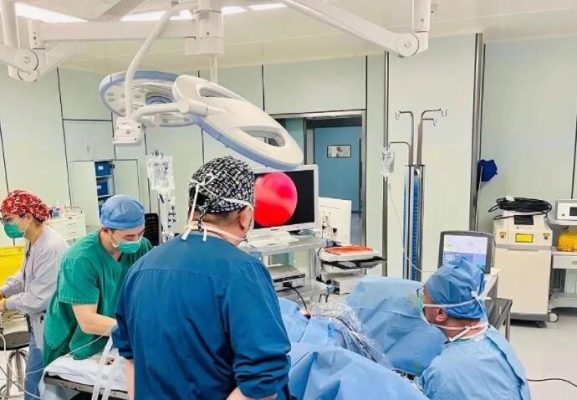Diferencias en la aplicación de los compuestos de fibra de carbono CF/PEEK y los compuestos de fibra de carbono tradicionales en la industria médica
Since carbon fiber composite materials were developed in the 1950s, they have been widely used in the aerospace field due to their excellent performance. With the continuous deepening and improvement of human research on carbon fiber composite materials, the application of carbon fiber composite materials is also increasing. At present, they have been widely used in aerospace, medical, automotive, construction, sports goods and other fields.
There are two main types of carbon fiber composite materials on the market: one is thermosetting carbon fiber composite materials , represented by epoxy thermosetting carbon fiber composite materials, and the other is thermoplastic carbon fiber composite materials , represented by CF/PEEK. According to the weaving texture of carbon fiber cloth, it can be divided into plain weave, twill, satin weave and unidirectional composite materials.

Figure 1 Carbon fiber cloth weaving texture forms (from left to right: plain, twill, satin, unidirectional)
Epoxy thermosetting carbon fiber composites
Epoxy thermosetting carbon fiber composite materials have mature production technology in China. The texture of epoxy thermosetting carbon fiber composite materials is mainly woven, and some special industries use unidirectional weaving. It is currently mainly used in automobiles and other industries. The carbon fiber content is normally 60%-70%, and the remaining 30%-40% is epoxy resin glue. The density of the finished product is generally around 1.7g/cm3.
advantage
1: High strength, because its carbon fiber content is as high as 60%-70%, the rigidity of the material is particularly strong. Some of its mechanical properties are completely superior to aluminum alloy.
2: Lightweight, it can reduce weight by 40% compared to aluminum alloy and 78% compared to stainless steel.
3: X-ray transmittance. Carbon fiber itself has good X-ray transmittance, and after being processed into composite materials, it still maintains good light transmittance.
4: The processing size is stable. In addition to the use of carbon fiber cloth, the epoxy resin itself has little deformation at room temperature after curing, so the material stability is good and there will be no obvious deformation after processing.
shortcoming
1: Brittleness, because epoxy resin itself has more rigid groups and fewer flexible groups, and after cross-linking and curing, it forms a network structure, which makes the product brittle and not impact-resistant. It is easy to collapse, crack or even delaminate during processing. Therefore, it is not suitable for processing some orthopedic medical devices.


(The above picture shows that the epoxy thermosetting carbon fiber composite material device cracked during use)
2: Poor resistance to moisture and heat hydrolysis. It is difficult to ensure that the resin or curing agent reacts completely during epoxy molding, resulting in poor hydrolysis and moisture and heat resistance of epoxy carbon fiber boards. Therefore, epoxy carbon fiber composite materials should not be used repeatedly.
3: The temperature resistance is relatively lower than that of thermoplastic carbon fiber composite materials. The carbon fiber material itself can withstand high temperatures of thousands of degrees Celsius, but the normal temperature that conventional epoxy resin can withstand is only 150°C. When the temperature exceeds 200°C, the epoxy resin will emit smoke, and it will basically start to carbonize at 300°C.
4: Difficult to process, because carbon fiber itself causes great wear to the tool, so it is difficult to process precision parts made of carbon fiber. At the same time, the processed powder will wear the screw after entering the machine tool guide rail, affecting the processing accuracy of the machine tool.
5: The bonding strength between epoxy resin and carbon fiber is not good, and black powder particles will be produced after wear.
6: The material cannot be recycled or reused
CF/PEEK thermoplastic carbon fiber composite material
CF/PEEK thermoplastic carbon fiber composite materials are generally based on satin weaving. The gaps between the satin patterns are large, and the staggered gaps are more conducive to the impregnation or wetting of PEEK rubber. PEEK material has poor fluidity and fast cooling and curing speed. Therefore, the difficulty of wetting carbon fiber composite materials is much higher than that of epoxy carbon fiber composite materials. PEEK thermoplastic composite materials generally have a carbon fiber ratio of 50~60%. The density is generally around 1.56g/cm3. As a special high-performance engineering plastic, PEEK itself has many performance advantages that ordinary materials do not have, such as high strength, high temperature resistance, self-lubrication, hydrolysis resistance, corrosion resistance, etc. Therefore, PEEK-type carbon fiber composite materials have better performance than ordinary epoxy-type carbon fiber composite materials, solving many problems existing in epoxy-type composite materials. Because PEEK itself is relatively expensive and the process molding is difficult, the price of PEEK thermoplastic composite materials is also relatively expensive. It is currently widely used in the medical industry.


advantage
1: High strength. PEEK itself is a high-strength engineering plastic. Therefore, after PEEK and carbon fiber are compounded, some of the mechanical properties of the composite material have exceeded those of ordinary metals, such as aluminum alloy.
2: Light weight, only 1/2 of the weight of aluminum alloy and only 1/5 of the weight of stainless steel.
3: X-ray transmittance. Both PEEK and carbon fiber have good X-ray transmittance and can still maintain good light transmittance after being processed into composite materials.
4: The processing size is stable. Because the material is made of woven carbon fiber cloth, the material has good stability and will not be deformed after processing.
5: High temperature resistance, PEEK’s temperature resistance far exceeds that of epoxy resin, and it can be used for a long time at 260°C. After compounding, it can withstand repeated deformation.
6: Corrosion resistance. Both carbon fiber and PEEK are resistant to general chemical corrosion, especially PEEK. Generally, no chemical reaction occurs during the composite process. After composite, PEEK forms another layer of coating on the carbon fiber, making the corrosion resistance of the composite material even more outstanding.
7: The interlayer bonding strength is good. The PEEK carbon fiber composite material produced by Jiangsu Junhua is not easy to delaminate. When thermoplastics are molded, the bonding strength after melting is high. Therefore, it is not easy to delaminate. From the perspective of the bonding between PEEK and carbon fiber, the bonding strength between PEEK and carbon fiber is very high, so the fiber release phenomenon is greatly reduced or absent. In addition, because PEEK has anti-creep force, PEEK polymer can withstand relatively large pressure for a long time, will not expand over time, and has good fiber-matrix interface bonding strength.
8: Impact resistance. Thermoplastic resins are usually linear molecular chains, because of their good toughness and high impact energy resistance.
9: Recyclable. Thermoplastic carbon fiber composite materials have the characteristic advantage of being directly recyclable.
10: Foreign scientific experiments have proved that implantable carbon fiber reinforced polyetheretherketone composites are not only non-cytotoxic, but also can promote protein synthesis and osteogenesis of bone cells. When used as artificial joint prostheses, they show good osteoblast proliferation and adhesion capabilities. The interface bonding strength between carbon fiber reinforced polyetheretherketone composites and bones is better than other artificial joint materials. The clinical application efficacy is significantly better than that of metal materials products. It can fundamentally alleviate the current problems of prosthesis loosening complications caused by mechanical and biological incompatibility of metal materials in joint prostheses.


shortcoming
1: Expensive. At present, the domestic PEEK thermoplastic carbon fiber composite material has just started, and the cost of production and research and development is relatively high. Therefore, the price of the material is also relatively expensive.
2: Difficulty in processing, because carbon fiber causes greater wear on the tool, so the processing cost of the composite material is high and the processing is difficult. Currently, all carbon fiber composite materials have this problem.
3: There are currently few domestic production units, and it is difficult to find a suitable purchasing unit
In the past two years, some domestic companies have begun to develop CF/PEEK thermoplastic carbon fiber composite materials, and Jiangsu Junhua is one of them. At present, the thermoplastic PEEK carbon fiber composite materials produced by Jiangsu Junhua have passed the mechanical property test and are used by many well-known domestic medical device companies for aiming frames of medical intramedullary nail equipment. It has been verified that the aiming frame processed by thermoplastic CF/PEEK carbon fiber composite materials has good light transmittance, high strength, and stable dimensional stability. It can still be accurately positioned after 100 disinfections.
«In summary, you should have a preliminary understanding of how to choose different types of carbon fiber composite materials for different products. I hope this article will be helpful to you.»



